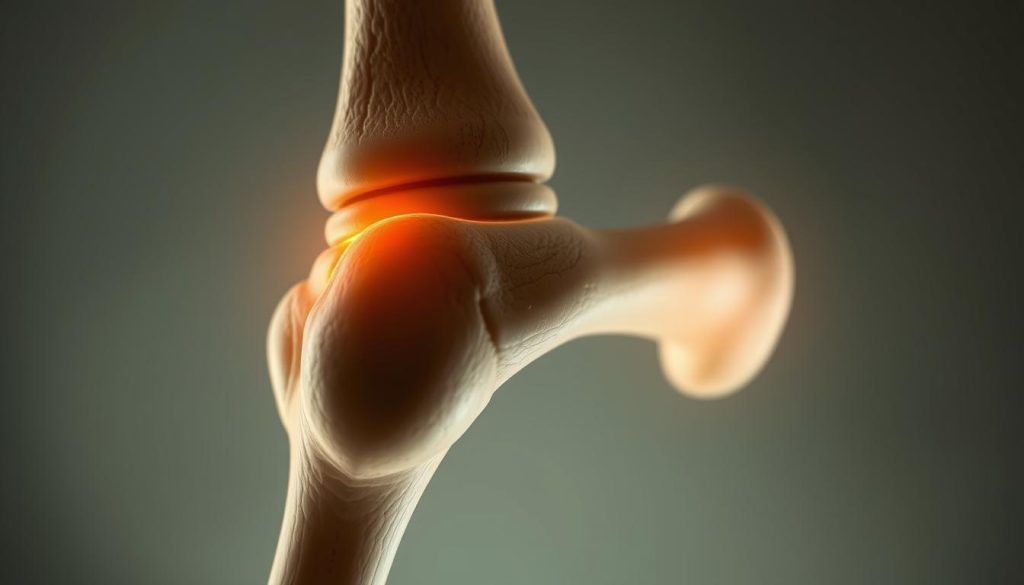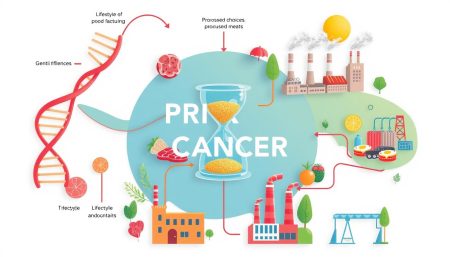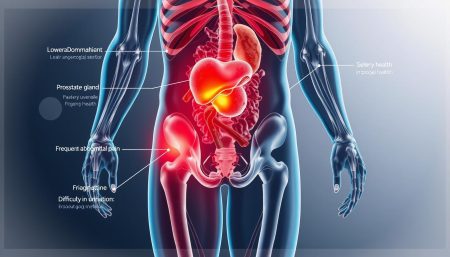Bone cancer symptoms can be hard to spot at first. This makes it very important to catch them early. Knowing the signs of bone tumors can lead to better treatment and outcomes.
Signs like persistent bone pain or unexplained swelling are important to watch for. We’ll look at these signs closely. This will help you know when to see a doctor.
While these symptoms don’t always mean cancer, it’s good to be careful about your health. Let’s explore bone cancer symptoms together. Knowing these signs can help you stay healthy.
What is Bone Cancer and Its Common Types
Bone cancer is a rare but serious condition where abnormal cells grow in bone tissue. It can start in the bones or spread from other parts of the body. Knowing the types and risk factors of bone cancer is key for early detection and treatment.
Primary Bone Cancer vs. Secondary Bone Cancer
Primary bone cancer starts in the bone itself. Secondary bone cancer, or metastatic bone cancer, spreads to the bones from other organs. Both types affect bone health, but their origins and treatments are different.
Most Prevalent Types of Bone Malignancies
The most common bone tumors include osteosarcoma, Ewing sarcoma, and chondrosarcoma. Each type affects different age groups and bone areas. Bone marrow edema can sometimes be an early sign of these conditions.
| Bone Cancer Type | Typical Age Group | Common Location |
|---|---|---|
| Osteosarcoma | Teens and young adults | Long bones (arms/legs) |
| Ewing Sarcoma | Children and teens | Pelvis, chest wall, legs |
| Chondrosarcoma | Adults over 40 | Pelvis, upper leg, shoulders |
Risk Factors and Genetic Predisposition
Several factors can increase the risk of developing bone cancer. These include previous radiation therapy, certain genetic conditions, and family history. Genetic predisposition plays a significant role in some bone cancer types, highlighting the importance of knowing your family medical history.
While genetic factors are uncontrollable, maintaining a healthy lifestyle and staying aware of symptoms can aid in early detection. Regular check-ups and prompt attention to persistent bone pain or swelling are key steps in managing bone health.
Recognizing Bone Cancer Symptoms
Spotting bone cancer symptoms early is key for quick diagnosis and treatment. Knowing common signs helps you get medical help fast.
Bone pain is a common first sign of bone cancer. It might start as a mild ache but gets worse over time. This pain can be constant or come and go, making daily activities hard.
Swelling around the affected area is another important sign. You might see your limb getting bigger or changing shape. It can also feel tender or warm to the touch. This swelling can make it hard to move the affected joint or limb.
| Symptom | Description | When to Seek Help |
|---|---|---|
| Bone Pain | Persistent, worsening pain in bones or joints | If pain lasts more than 2 weeks |
| Swelling | Noticeable enlargement near affected bone | When swelling persists or grows |
| Fractures | Unexplained bone breaks from minor injuries | Immediate medical attention needed |
| Fatigue | Unusual tiredness or weakness | If persistent for several weeks |
Other symptoms include unexplained weight loss, fatigue, and fever. If you notice any of these signs, or if they get worse, see a doctor right away.
The Critical Role of Persistent Bone Pain
Persistent bone pain is a major sign of bone cancer. Knowing how to spot this pain can help find cancer early. Let’s look at how to tell if pain is from cancer and what it feels like.
Distinguishing Cancer Pain from Regular Pain
Bone pain from cancer doesn’t go away and gets worse. It feels deep and aching, unlike regular soreness. If your bone pain doesn’t get better with rest or medicine, see a doctor.
Pain Patterns and Intensity Levels
Persistent pain from bone cancer starts off mild but gets worse. It can be constant or come and go, getting worse with activity. Some say it starts as a dull ache and turns into sharp pain.
Pain levels change, but it usually gets worse as the cancer grows.
Nighttime Pain Characteristics
Nighttime pain is a big warning sign for bone cancer. Many find their pain gets worse at night, making it hard to sleep. This nighttime discomfort can feel more intense and may cause sweating. If your bone pain gets worse at night, get medical help right away.
| Pain Characteristic | Regular Pain | Cancer-Related Pain |
|---|---|---|
| Duration | Usually temporary | Persistent, worsening |
| Response to Rest | Often improves | Little to no improvement |
| Nighttime Intensity | Generally consistent | Often increases |
Understanding Bone Fractures as Warning Signs
Bone fractures can signal bone cancer, even with little injury. Cancer makes bones weak, leading to pathological fractures. These breaks happen in areas where cancer has weakened bones.
Bone density loss often causes fractures. But, if it happens without usual risk factors, it’s important to look into it more. Unexplained fractures in people without osteoporosis risk should make you worry.
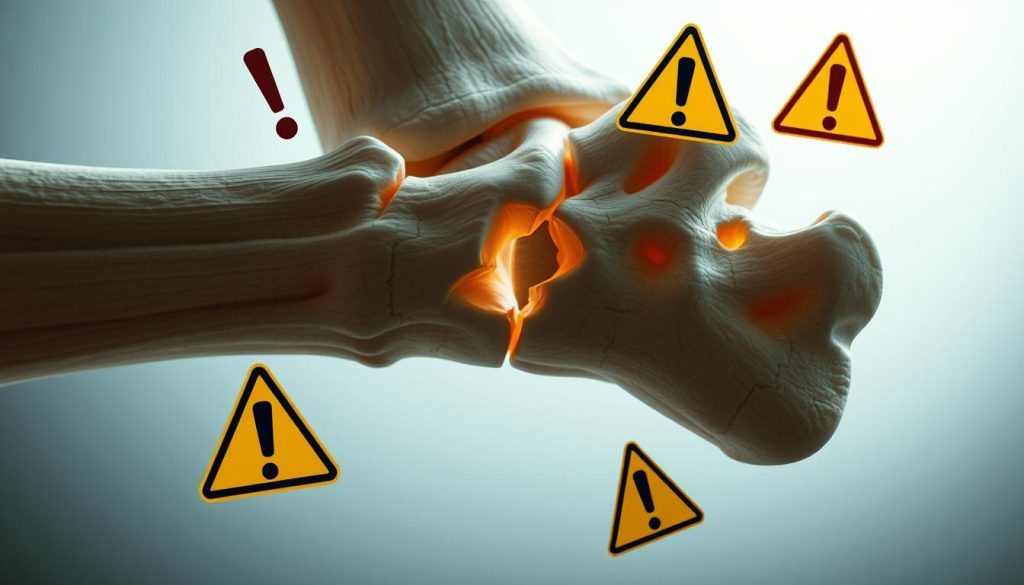
Pathological fractures are different from usual breaks. They can happen from simple activities that shouldn’t cause harm. For example, a simple stretch or a mild bump might break a bone weakened by cancer.
| Type of Fracture | Cause | Risk Level for Bone Cancer |
|---|---|---|
| Traumatic | Significant force or impact | Low |
| Stress | Repetitive force over time | Moderate |
| Pathological | Minimal force on weakened bone | High |
If you have unexplained fractures or ongoing bone pain, see a doctor right away. Catching bone cancer early can greatly improve treatment and life quality.
Swelling and Inflammation Around Affected Areas
Bone cancer can cause noticeable changes in the body. Swelling and inflammation are important signs to watch for. These symptoms can show up in different parts of the body, depending on the cancer’s location.
Visual Changes in Affected Limbs
Bone cancer can make limbs look different. You might see swelling or a lump near the bone. The area might feel warm and look red or puffy.
These changes often happen slowly over time.
Tissue Inflammation Patterns
Inflammation patterns can vary. Some people have constant swelling, while others see it come and go. The affected area might feel tight or stretched.
In some cases, the skin over the swollen area looks shiny or taut.
When to Seek Medical Attention
Knowing when to see a doctor is important. Seek medical help if:
- Swelling lasts more than two weeks
- The affected limb becomes painful or limits movement
- You notice rapid growth in the swollen area
- The swelling is accompanied by fever or unexplained weight loss
Early detection is key to better treatment outcomes. Don’t hesitate to reach out to a healthcare provider if you’re worried about persistent swelling or inflammation in your limbs.
Movement Limitations and Mobility Issues

Bone cancer can make it hard to move freely. Tumors growing can cause limping and stiff joints. These issues make daily tasks tough and get worse over time.
Limping is a common sign of bone cancer in the legs. People might lean on one leg more or feel pain when standing on it. This uneven walking can put extra stress on other parts of the body, causing more pain.
Joint stiffness is another sign of bone cancer. Tumors near joints can limit movement, making it hard to bend or straighten the area. This stiffness is often worse in the morning or after sitting for a while.
- Difficulty climbing stairs
- Reduced range of motion in affected joints
- Trouble with fine motor skills
- Increased fatigue during physical activities
As bone cancer gets worse, mobility problems get more severe. Simple tasks like getting dressed or cooking can become hard. It’s important for those with ongoing movement issues to see a doctor for help and early treatment.
Systemic Symptoms: Fatigue and Weight Loss
Bone cancer isn’t just about your bones. It can affect your whole body. Symptoms like unexplained weight loss and fatigue are common.
Understanding Unexplained Weight Changes
Weight loss without dieting or lifestyle changes is a warning sign. Cancer cells burn a lot of energy, causing weight loss. Losing 10 pounds or more without trying means it’s time to see a doctor.
Fatigue Patterns in Bone Cancer
Feeling tired all the time is common with bone cancer. It’s not just normal tiredness. Cancer-related fatigue is deep and lasts a long time. You might feel exhausted even after sleeping or find daily tasks too tiring.
Related Systemic Manifestations
Other body-wide symptoms can occur with bone cancer. These may include:
- Night sweats
- Low-grade fever
- Loss of appetite
- General feeling of being unwell
| Symptom | Description | When to Seek Help |
|---|---|---|
| Weight Loss | Unexplained loss of 10+ pounds | Within 1-2 months |
| Fatigue | Persistent tiredness not relieved by rest | Lasts 2+ weeks |
| Night Sweats | Waking up with drenched sheets | Occurs 3+ times a week |
Remember, these symptoms don’t always mean cancer. But if you have bone pain or swelling, get checked out. Early detection can greatly improve treatment outcomes.
The Significance of Night Sweats

Night sweats can be a sign of bone cancer. This symptom is often overlooked or blamed on other things. It’s key to understand the connection between night sweats and bone cancer for early treatment.
Bone cancer shows itself in different ways. Pain and swelling are common, but night sweats are a sign of the disease’s impact on the body. These sweats happen when the body can’t regulate its temperature, often because of the cancer’s effect on the immune system.
The severity of night sweats can vary. Some people might just feel a bit damp, while others wake up soaked. These episodes usually happen while you’re sleeping and can be followed by chills or fever.
| Characteristic | Night Sweats in Bone Cancer |
|---|---|
| Frequency | Often recurring, multiple times per week |
| Time of Occurrence | Primarily during sleep |
| Associated Symptoms | May include fever, chills, fatigue |
| Severity | Can range from mild to severe |
Remember, night sweats alone don’t mean you have bone cancer. They can be caused by many things, like infections or hormonal changes. If you have persistent night sweats and other symptoms of bone cancer, see a doctor for a check-up.
Diagnostic Approaches for Bone Cancer
Diagnosing bone cancer involves several steps. Doctors use imaging, biopsies, and blood tests. These help confirm bone cancer and its type and stage.
Imaging Technologies Used
Imaging is key in diagnosing bone cancer. X-rays show bone issues. MRI scans detail soft tissues and bone marrow. PET scans spot cancer spread.
These tools help doctors see tumors. They plan treatments based on these images.
Biopsy Procedures
A biopsy is vital for a bone cancer diagnosis. Doctors take a small tissue sample for lab tests. There are two biopsy types:
- Needle biopsy: A thin needle takes a sample
- Surgical biopsy: A small incision removes a larger sample
Pathologists look at the sample under a microscope. They find cancer cells and identify the bone cancer type.
Blood Test Indicators
Blood tests can’t diagnose bone cancer alone. But, they offer insights into health and cancer effects. Doctors check for:
- Elevated alkaline phosphatase levels, an enzyme from bone cells
- Signs of anemia or infection
- Markers for cancer spread to other organs
These methods together give a full picture. They guide treatment and improve patient care.
Early Detection and Prevention Strategies
Early detection is key to better outcomes for bone cancer patients. Regular check-ups and quick action on symptoms can greatly improve chances. While some bone cancers can’t be prevented, there are ways to lower your risk and keep your bones healthy.
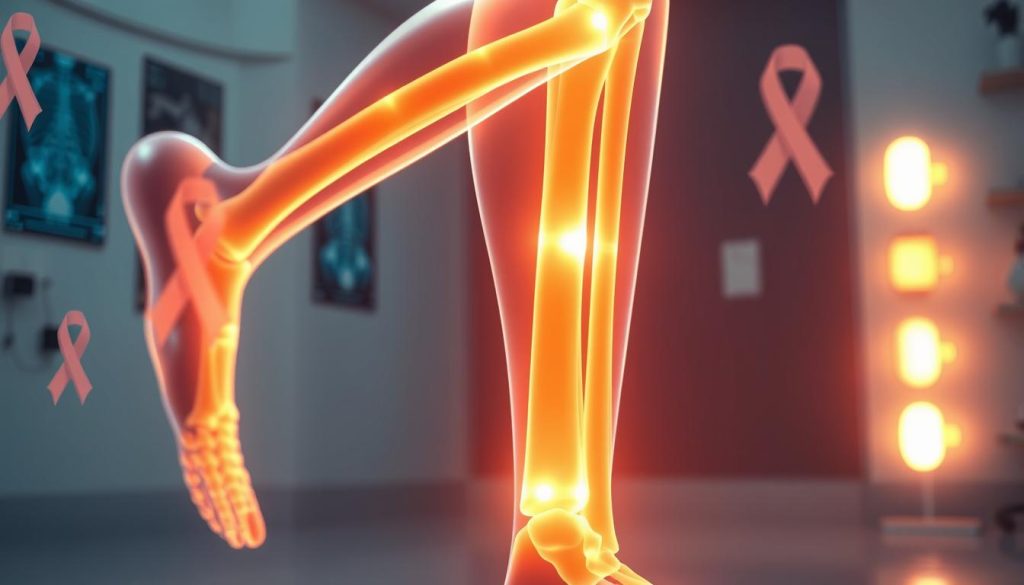
Watch for any unusual pain or swelling in your bones or joints. If you have ongoing discomfort, see your doctor right away. They might suggest tests or blood work to check for serious issues.
Here are some ways to lower your risk of bone cancer:
- Eat a diet full of calcium and vitamin D
- Do regular exercises that make your bones stronger
- Stay away from too much alcohol and tobacco
- Try to avoid radiation and harmful chemicals
If you have a family history of bone cancer or a genetic risk, talk to a genetic counselor. They might suggest more frequent tests. By following these tips and keeping an eye on your bone health, you can help prevent bone cancer and catch it early.
Treatment Options and Recovery Timeline
Bone cancer treatment is a mix of different approaches for each patient. The journey from finding out you have cancer to getting better is tough. But knowing what treatments are available helps patients get ready for what’s next.
Surgical Interventions
Surgery is a key part of treating bone cancer. It tries to take out the tumor and keep healthy tissue. Sometimes, patients can keep their limb if the surgery is done right.
Recovering from surgery can take weeks or even months. This depends on how big the surgery was.
Radiation Therapy Approaches
Radiation therapy uses beams to shrink tumors and kill cancer cells. It’s used before surgery to make tumors smaller or after to get rid of any left-over cancer. Treatment lasts for weeks, and healing takes months.
Chemotherapy Protocols
Chemotherapy attacks cancer cells all over the body. It’s given in cycles, with breaks in between. The whole treatment can last several months.
Getting better from chemotherapy side effects can take weeks or months after treatment stops.
| Treatment | Duration | Recovery Time |
|---|---|---|
| Surgery | 1-8 hours | Weeks to months |
| Radiation Therapy | 5-7 weeks | 3-6 months |
| Chemotherapy | 3-6 months | 6-12 months |
How long it takes to recover varies a lot. Some people get back to normal in months, while others need a year or more. It’s important to keep up with follow-up visits to check on how you’re doing and deal with any treatment side effects.
Living with Bone Cancer: Daily Management
Living with bone cancer means managing it every day. It changes how you live. Knowing how to handle these changes is important for a good life.

Pain is a big worry for many. Some find relief in medicine and other treatments. Gentle exercises, with doctor’s approval, can also help. It’s important to see your doctor regularly to adjust your pain plan.
Doing daily tasks can be hard. Occupational therapists can help. They suggest tools and ways to make tasks easier. For example, grab bars in the bathroom or special kitchen tools.
| Daily Task | Adaptation Strategy |
|---|---|
| Bathing | Install shower chair and handheld showerhead |
| Dressing | Use button hooks and long-handled shoe horns |
| Cooking | Utilize electric can openers and jar grippers |
| Mobility | Consider a cane or walker for stability |
Feeling good emotionally is also key. Support groups are great for sharing and learning. Keeping up with friends and hobbies can also help your mood and life quality.
Support Systems and Resources
Living with bone cancer can be tough, but you’re not alone. A strong support system is key. Let’s look at the bone cancer support options to help you through this tough time.
Patient resources are plentiful. Online communities let you connect with others who get what you’re going through. These forums are great for sharing stories, asking questions, and finding emotional support.
Local support groups are also very helpful. They meet in person, allowing you to connect with others nearby who face bone cancer. Talking face-to-face can be really healing and helps fight off feelings of loneliness.
Patient advocacy groups offer lots of help. They provide educational materials, financial aid, and help managing symptoms. These groups often host events and workshops to support patients and their families.
Don’t overlook professional help. Social workers, counselors, and psychologists can offer emotional and practical support. They help you find ways to cope and navigate the healthcare system.
Remember, asking for help is a sign of strength, not weakness. Using these patient resources can greatly improve your life and make you feel more in control during your bone cancer journey.
Latest Research and Treatment Advances
The world of bone cancer research is moving fast. Scientists are finding new ways to fight this tough disease. This gives hope to patients and their families.
Recent breakthroughs have opened doors to new treatments. These treatments show promise in improving outcomes.
Emerging Therapies
Immunotherapy is a big change in bone cancer treatment. It uses the body’s immune system to attack cancer cells. Targeted treatments are also becoming more common.
These therapies focus on specific genetic changes in cancer cells. They might offer better and less toxic options for patients.
Clinical Trial Opportunities
Clinical trials are key in advancing bone cancer care. They let patients try new treatments before they’re widely available. Many trials are looking at combining existing therapies with new drugs.
This aims to make treatments more effective and reduce side effects. Patients can find out more through their doctors or reputable cancer research organizations.
Future Treatment Prospects
The future of bone cancer treatment looks bright. Researchers are working on personalized medicine. This means treatments tailored to each person’s genetic profile.
Gene therapy and nanotechnology are also being explored. These could lead to more precise and effective treatments. They might change bone cancer care in the years to come.
FAQ
Q: What are the most common early symptoms of bone cancer?
A: Early signs of bone cancer include persistent pain, swelling, and visible lumps. You might also experience unexplained fractures and limited mobility. Fatigue and weight loss are other symptoms.
Q: How is bone pain from cancer different from regular pain?
A: Bone cancer pain is constant and gets worse over time. It’s often worse at night and doesn’t go away with rest or pain meds. It can be constant or come and go, getting worse with activity.
Q: Can bone cancer cause fractures?
A: Yes, bone cancer can lead to fractures. These happen when the bone is weakened by cancer. Even a small fall can cause a fracture. If you have unexplained fractures, get checked for bone cancer.
Q: What types of imaging tests are used to diagnose bone cancer?
A: To find bone cancer, doctors use X-rays, MRI, CT scans, bone scans, and PET scans. These help see bone changes and find tumors.
Q: Are there any blood tests that can detect bone cancer?
A: There’s no single blood test for bone cancer. But, some tests can show useful info. These include tests for alkaline phosphatase and tumor markers. A biopsy and imaging studies are usually needed for a diagnosis.
Q: What are the main treatment options for bone cancer?
A: Treatments for bone cancer include surgery, radiation, and chemotherapy. The best plan depends on the cancer’s type, stage, and where it is. It also depends on your overall health.
Q: Can bone cancer be prevented?
A: Some bone cancers can’t be prevented, but you can lower your risk. Stay healthy, avoid harmful substances, and know your family’s health history. Catching symptoms early is key to better treatment.
Q: What is the difference between primary and secondary bone cancer?
A: Primary bone cancer starts in the bone. Secondary bone cancer happens when cancer spreads to the bones from another place. Secondary bone cancer is more common.
Q: How does bone cancer affect mobility?
A: Bone cancer can make it hard to move. It causes pain, stiffness, and weakness. This can lead to limping, reduced motion, and trouble with daily tasks. In bad cases, it can make a limb useless.
Q: Are night sweats a symptom of bone cancer?
A: Yes, night sweats can be a sign of bone cancer. They’re less common than pain or swelling. Night sweats are the body’s reaction to cancer. If you have them often, see a doctor.












